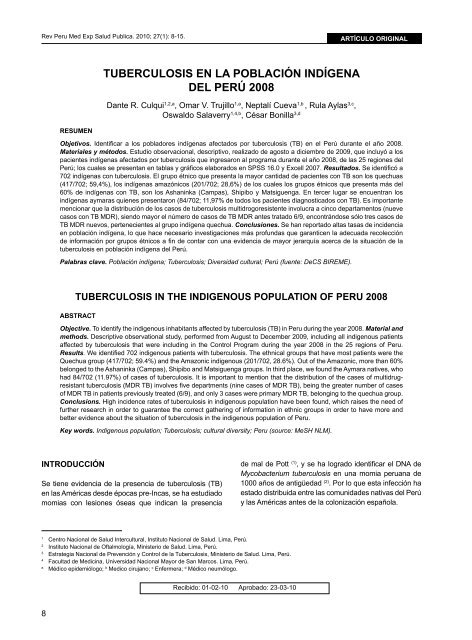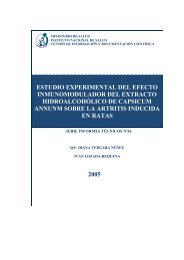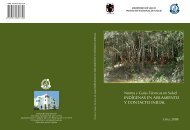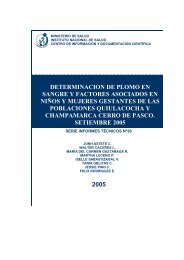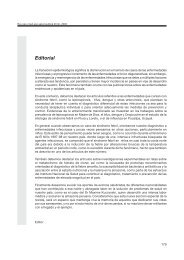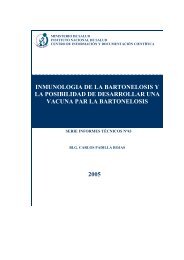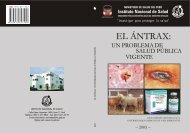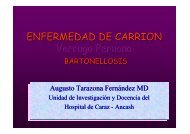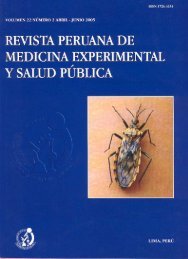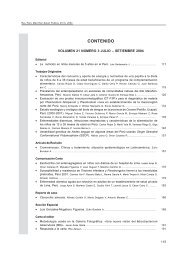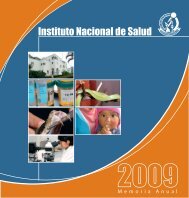rEVISta PErUaNa dE MEdIcINa ExPErIMENtaL y SaLUd PÃbLIca ...
rEVISta PErUaNa dE MEdIcINa ExPErIMENtaL y SaLUd PÃbLIca ...
rEVISta PErUaNa dE MEdIcINa ExPErIMENtaL y SaLUd PÃbLIca ...
You also want an ePaper? Increase the reach of your titles
YUMPU automatically turns print PDFs into web optimized ePapers that Google loves.
Rev Peru Med Exp Salud Publica. 2010; 27(1): 8-15.<br />
artículo original<br />
TUBERCULOSIS EN LA POBLACIÓN INDÍGENA<br />
DEL PERÚ 2008<br />
Dante R. Culqui 1,2,a , Omar V. Trujillo 1,a , Neptalí Cueva 1,b , Rula Aylas 3,c ,<br />
Oswaldo Salaverry 1,4,b , César Bonilla 3,d<br />
RESUMEN<br />
Objetivos. Identificar a los pobladores indígenas afectados por tuberculosis (TB) en el Perú durante el año 2008.<br />
Materiales y métodos. Estudio observacional, descriptivo, realizado de agosto a diciembre de 2009, que incluyó a los<br />
pacientes indígenas afectados por tuberculosis que ingresaron al programa durante el año 2008, de las 25 regiones del<br />
Perú; los cuales se presentan en tablas y gráficos elaborados en SPSS 16.0 y Excell 2007. Resultados. Se identificó a<br />
702 indígenas con tuberculosis. El grupo étnico que presenta la mayor cantidad de pacientes con TB son los quechuas<br />
(417/702; 59,4%), los indígenas amazónicos (201/702; 28,6%) de los cuales los grupos étnicos que presenta más del<br />
60% de indígenas con TB, son los Ashaninka (Campas), Shipibo y Matsiguenga. En tercer lugar se encuentran los<br />
indígenas aymaras quienes presentaron (84/702; 11,97% de todos los pacientes diagnosticados con TB). Es importante<br />
mencionar que la distribución de los casos de tuberculosis multidrogoresistente involucra a cinco departamentos (nueve<br />
casos con TB MDR), siendo mayor el número de casos de TB MDR antes tratado 6/9, encontrándose sólo tres casos de<br />
TB MDR nuevos, pertenecientes al grupo indígena quechua. Conclusiones. Se han reportado altas tasas de incidencia<br />
en población indígena, lo que hace necesario investigaciones más profundas que garanticen la adecuada recolección<br />
de información por grupos étnicos a fin de contar con una evidencia de mayor jerarquía acerca de la situación de la<br />
tuberculosis en población indígena del Perú.<br />
Palabras clave. Población indígena; Tuberculosis; Diversidad cultural; Perú (fuente: DeCS BIREME).<br />
TUBERCULOSIS IN THE INDIGENOUS POPULATION OF PERU 2008<br />
ABSTRACT<br />
Objective. To identify the indigenous inhabitants affected by tuberculosis (TB) in Peru during the year 2008. Material and<br />
methods. Descriptive observational study, performed from August to December 2009, including all indigenous patients<br />
affected by tuberculosis that were including in the Control Program during the year 2008 in the 25 regions of Peru.<br />
Results. We identified 702 indigenous patients with tuberculosis. The ethnical groups that have most patients were the<br />
Quechua group (417/702; 59.4%) and the Amazonic indigenous (201/702, 28.6%). Out of the Amazonic, more than 60%<br />
belonged to the Ashaninka (Campas), Shipibo and Matsiguenga groups. In third place, we found the Aymara natives, who<br />
had 84/702 (11.97%) of cases of tuberculosis. It is important to mention that the distribution of the cases of multidrugresistant<br />
tuberculosis (MDR TB) involves five departments (nine cases of MDR TB), being the greater number of cases<br />
of MDR TB in patients previously treated (6/9), and only 3 cases were primary MDR TB, belonging to the quechua group.<br />
Conclusions. High incidence rates of tuberculosis in indigenous population have been found, which raises the need of<br />
further research in order to guarantee the correct gathering of information in ethnic groups in order to have more and<br />
better evidence about the situation of tuberculosis in the indigenous population of Peru.<br />
Key words. Indigenous population; Tuberculosis; cultural diversity; Peru (source: MeSH NLM).<br />
INTRODUCCIÓN<br />
Se tiene evidencia de la presencia de tuberculosis (TB)<br />
en las Américas desde épocas pre-Incas, se ha estudiado<br />
momias con lesiones óseas que indican la presencia<br />
de mal de Pott (1) , y se ha logrado identificar el DNA de<br />
Mycobacterium tuberculosis en una momia peruana de<br />
1000 años de antigüedad (2) . Por lo que esta infección ha<br />
estado distribuida entre las comunidades nativas del Perú<br />
y las Américas antes de la colonización española.<br />
1<br />
Centro Nacional de Salud Intercultural, Instituto Nacional de Salud. Lima, Perú.<br />
2<br />
Instituto Nacional de Oftalmología, Ministerio de Salud. Lima, Perú.<br />
3<br />
Estrategia Nacional de Prevención y Control de la Tuberculosis, Ministerio de Salud. Lima, Perú.<br />
4<br />
Facultad de Medicina, Universidad Nacional Mayor de San Marcos. Lima, Perú.<br />
a<br />
Médico epidemiólogo; b Medico cirujano; c Enfermera; d Médico neumólogo.<br />
Recibido: 01-02-10 Aprobado: 23-03-10<br />
8


